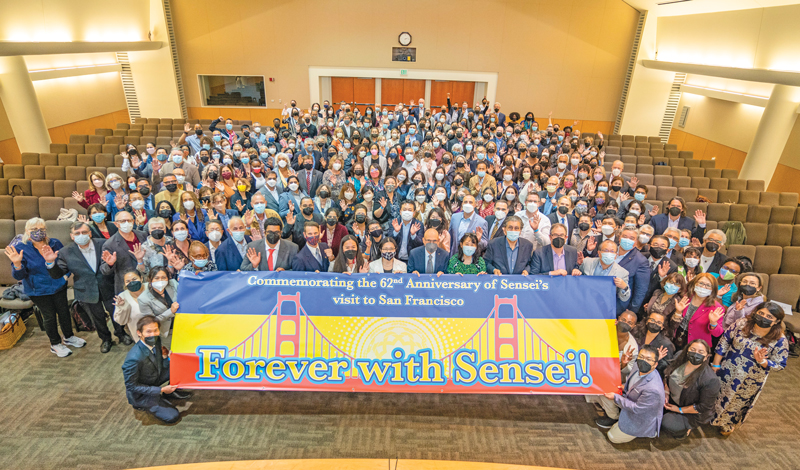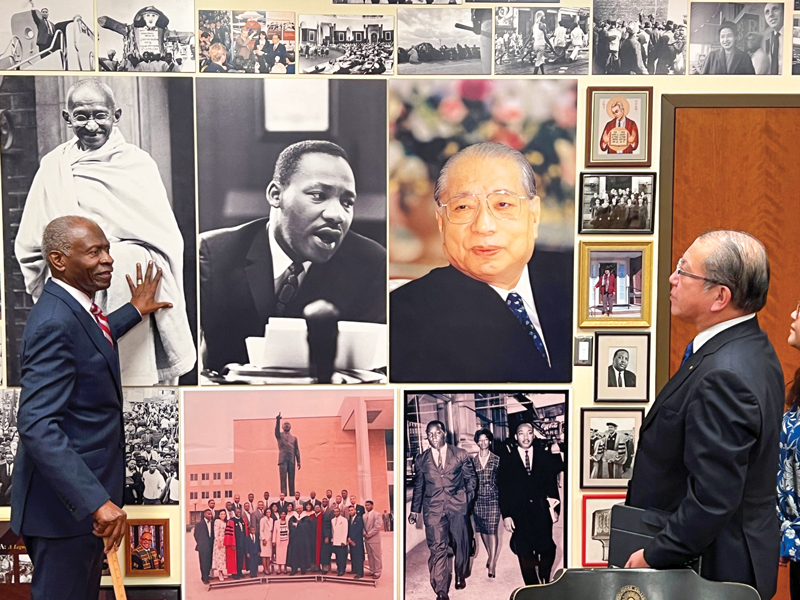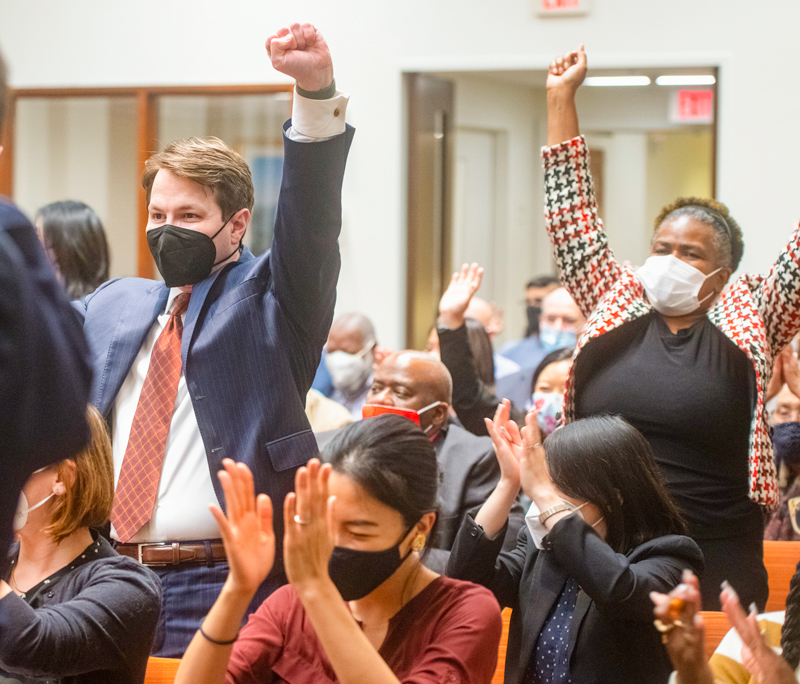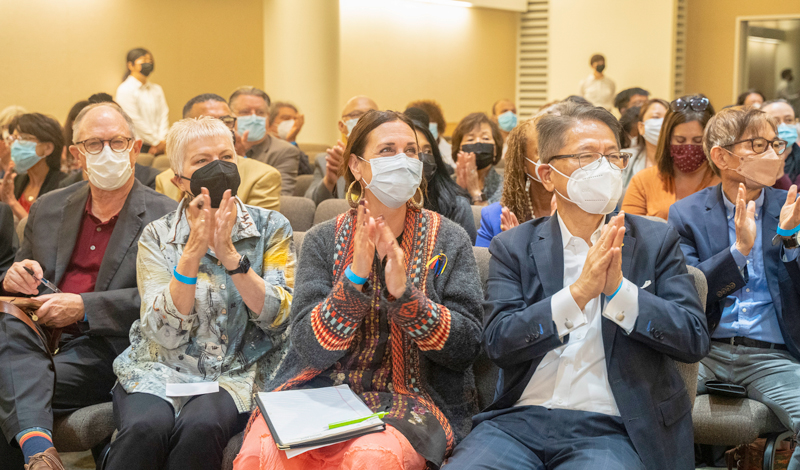On the heels of SGI World Peace Day, representative leaders gathered in San Francisco (Oct. 9), Atlanta (Oct. 11) and Washington D.C. (Oct. 13) for dynamic meetings toward Nov. 18, led by SGI Vice President Yoshiki Tanigawa.
In a weeklong sprint across the U.S., Mr. Tanigawa also met with Ikeda Sensei’s treasured friends Lawrence E. Carter, dean of the Martin Luther King Jr. International Chapel at Morehouse College and U.S. Rep. Hank Johnson in Washington D.C.
Sensei sent a powerful message to the meetings, calling on SGI-USA members to “make exemplary progress in advancing worldwide kosen-rufu.” He also emphasized the essential spirit needed to dauntlessly face hardships, saying:
Though you may have many challenges … I ask you to chant daimoku like roaring lions and advance courageously, with the conviction that it is by encountering hardship that you can accumulate great fortune that will last for eternity.
The following is Mr. Tanigawa’s address at the Northern California Dual Zone Leaders Meeting, held at the San Francisco Buddhist Center in San Francisco.
—Prepared by the World Tribune staff
Become People of Appreciation
by Yoshiki Tanigawa
SGI Vice President
I am truly honored and it brings me great joy to meet all of you, who are making incredible progress as a prominent driving force for kosen-rufu in America. Thank you very much!
San Francisco—this is where the first district in the United States mainland was formed and where Sensei established the future division. This is a vital starting point for kosen-rufu in America.
In addition, the United Nations was inaugurated here in this city that is significant in so many ways.
What’s more, Ikeda Sensei has visited San Francisco five times, conveying many important guiding principles in faith.
Today, together with all of you, I’d like to study and confirm the meaning of several of these guiding principles.
1. The first point is to become victors who win trust in society and people of appreciation who help all those around them cultivate happiness.
In March 1993, at the second SGI-USA Executive Conference here in San Francisco, Sensei shared two passages that Nichiren Daishonin wrote to a central figure among his disciples, Shijo Kingo:
Bring forth the great power of faith, and be spoken of by all the people of Kamakura, both high and low, or by all the people of Japan, as “Shijo Kingo, Shijo Kingo of the Lotus school!” Even a bad reputation will spread far and wide. A good reputation will spread even farther, particularly if it is a reputation for devotion to the Lotus Sutra.[1]
Live so that all the people of Kama-kura will say in your praise that Nakatsukasa Saburo Saemon-no-jo is diligent in the service of his lord, in the service of Buddhism, and in his concern for other people.[2]
After sharing these two passages, Sensei offered the following guidance:
The correct way of practice for those who embrace the Mystic Law is to show actual proof of victory based on faith and to win the respect and trust of others in society.
I hope all of you will be victors who are respected by many people as members of the SGI.[3]
He continues:
In a modern context, this means that not only should we naturally develop strong faith, but we must also cultivate brilliant character and humanity so as to become indispensable people in our places of work and in our communities, thereby winning the praise and respect of others.[4]
And for us to lead such lives, Sensei explains:
Taking care of the tasks at hand is important. The main thing is to make your goals clear and then set about achieving them one by one with steady and thorough efforts. Only through such continuous efforts can we open up the path before us. Also, we must never neglect the small details.[5]
Furthermore, he teaches us a vital point leaders should keep in mind:
People who can express their gratitude are truly happy. A life that is always filled with appreciation is a bright and cheerful one—be it when you are meeting with people, when someone gives you a lift in his or her car, or when you are at home with your family. Sincerely offering thanks is a sign of living truly happy lives. Where people embody such a sense of appreciation, they send out waves of happiness that envelop both themselves and others.
To voice your appreciation, it is important to say “thank you” to your fellow members and to your friends. Leaders who take the members’ sincere efforts for granted and assume a highhanded attitude toward them inevitably come to a deadlock because of their own arrogance. They bring bleakness and unhappiness to both themselves and others.
The expression thank you contains the essence of happiness. Those who appreciate the heart of these two words and use them generously are surely more eloquent than the most skilled of speakers.[6]
This guidance doesn’t mean that all we need to do is say “thank you.” There’s a profound Buddhist perspective that lies at the heart of this guidance.
If we return to the time when Sensei arrived to San Francisco for the first time, we can see that he carried out and exemplified this point.
As described in The New Human Revolution, vol. 1, “New World” chapter, a women’s division member who comes to the airport to welcome Sensei, introduces her husband, saying, “But he doesn’t practice yet; he does support my practice, though.”[7]
In response, Sensei says to her: “That’s enough, isn’t it? He happily came with you to welcome us. Doesn’t that make him an excellent member already?”
He then shook her husband’s hands, saying: “Thank you very much. I’d like to ask that you continue to support your wife and the Soka Gakkai.”
Sensei presented her husband with a pin commemorating his own inauguration as president.
The next day, when he formed the first district in San Francisco, he asked her husband to serve as an advisor to the district even though he had not yet taken faith. Sensei explains the reason for this appointment as follows:
I treasure people like [him]—people who, though not practicing faith themselves, have a good understanding of the Soka Gakkai and lend their support to our activities. Nothing is more gratifying. I want to show my utmost appreciation and respect for their contribution.
Many members tend to look at people simply in terms of whether they are practicing: If a person is a member, they feel reassured; if not, they feel uneasy. But this kind of thinking is wrong; it is not Buddhism. There are many fine people of upstanding character who don’t practice. When we look at how these people live, we see much that accords with the Buddhist way of life.
On the other hand, there are people who practice this faith yet cause trouble for their fellow members or society, or end up betraying the Soka Gakkai. Therefore, to think that those who practice are good and those who do not are bad is to make a terrible mistake.[8]
Moreover, Sensei, appearing as Shin’ichi Yamamoto, writes as follows:
In Shin’ichi’s mind there was no wall separating the Soka Gakkai from society. In accord with the principle that “Buddhism manifests itself in society,” those who practice Buddhism should naturally yearn for the happiness of all people and peace throughout the world.
Moreover, for example, a great mountain that rises from a broad base is not easily destroyed, whereas a sheer cliff is fragile and easily crumbles. To firmly establish kosen-rufu, the Soka Gakkai also needed to possess a solid base like that of a majestic mountain.
Thus, the support of people outside the organization—people from every walk of life—has been important. Shin’ichi was also keenly aware that the very presence of such friends would clearly attest to the validity of Nichiren Buddhism as a religion that exists for the people.[9]
There should be no wall separating the Soka Gakkai from society. To desire or yearn for the happiness of all people and peace in the world means appreciating all those around us and expanding and cultivating our realm of happiness. It might be easy for us to think that we are practicing the correct teaching, and that it’s the people who don’t practice who are putting up walls because of their prejudice and lack of understanding. However, in learning Sensei’s way of thinking, if we differentiate and judge people based on whether they practice Buddhism or not, we are the ones creating walls of separation.
Just as Nichiren says, “It is the heart that is important.”[10] Through the transformation of our own inner resolve, we can expand the bonds we share with the people around us—whether in our families, our places of work or our communities. We can do this more than ever before, from where we are right now. Let’s expand our ties and grow our network of happiness as we progress in our efforts for kosen-rufu.
As leaders in San Francisco, where Sensei taught this key principle, let’s keep in mind the importance of appreciating those around us, in our families, local SGI organization, at work, in our communities. Let’s be the ones who most express the words Thank you!

2. The second point I’d like to share is to carry out joyful and fulfilling activities and to experience and fully understand how wonderful our Buddhist practice is.
In The New Human Revolution, vol. 10, “Winds of Happiness” chapter, Sensei talks with chapter leader Tad Ozaki.
He says:
The important thing is for each individual to feel that there is no more enjoyable, fulfilling or wonderful realm as that of Buddhism. If that is accomplished, those individuals will develop into core leaders from whom the Daishonin’s teachings will spread widely.[11]
We could take this as an eternal guiding principle for kosen-rufu here in the United States.
In The New Human Revolution, vol. 1, “Golden Autumn” chapter, Sensei says:
A mother who loves her children and thinks constantly of their welfare knows what they want merely from their cries. Children, too, feel content and reassured when they hear their mother’s voice. Similarly, a leader who has a strong determination to cherish the members can understand their worries and desires, and the members will in turn respond to such a leader.
Leaders must also carefully consider what they are going to speak about and how to present it, so that the members will readily understand and accept what they have to say. It is important to continue making such efforts. When I have a meeting to attend, I always make sure that I am thoroughly prepared. I rack my brains and try to come up with creative ideas.
This is a leader’s duty. If a leader just talks about the same old thing and never offers anything fresh or new, it is discourteous to the listeners. It is a sign of an irresponsible leader who has fallen into force of habit.[12]
This is strict guidance for leaders, but I believe that we must take it to heart.
The joy that we strive to experience in our practice is not just a surface-level joy. It’s a deeper sense of joy that comes from bringing forth even more of our potential than before; from developing even more strengths that help us fulfill our mission; and growing even more so that we can advance in every aspect of our lives.
It also comes from deeply applying and understanding Nichiren Daishonin’s writings and Sensei’s guidance, resulting in the satisfying proof of overcoming longstanding issues that had once troubled us. This is the fulfillment and joy that we are talking about.
Sensei has said that true happiness comes from transforming into a person who is rich in heart; it means doing our human revolution. In order to help our fellow members grow and feel a sense of fulfillment from their Buddhist practice, we need to first aim to grow and develop ourselves, always having the attitude to keep challenging ourselves in this way. Those who help others grow are those who are always growing themselves. In that sense, we must always put forth new goals that we are challenging based on our faith, practice and study, becoming leaders who continue to grow in this way.
Sensei offers the following guidance:
Leaders are people who bring joy to others. This is the most fundamental requirement of a leader. …
I would like leaders to make efforts so that people will say about them: “That person really put my mind at ease. I was convinced, reassured and encouraged. I now feel more confident and full of hope.”[13]
Leaders who have a rich life force are able to warmly embrace members, encouraging them from the depths of their hearts and helping them tap into their courage and confidence. From such warm encouragement we can advance and expand our realm of joy, cheerfulness and understanding. Together, let’s reaffirm this important point.

3. The third point is to always advance powerfully by putting chanting daimoku first.
Sensei spoke at a youth training session in Malibu in April 1974, offering guidance on the significance of making chanting daimoku the foundation of faith. He said:
Nam-myoho-renge-kyo is a universal language that transforms life. Chanting is the only way to merge our lives with the great life of the universe. Through reciting the sutra and chanting Nam-myoho-renge-kyo, we are able to energize our lives and bring forth inner vitality. By doing so, we can polish our lives and manifest our Buddha nature.[14]
In addition, in March 1993, at the first SGI-USA Youth General Meeting in San Francisco, Sensei shared the following guidance:
Those who chant Nam-myoho-renge-kyo throughout their lives, whatever may happen, are victors in life. As long as you remember this, your lives will be secure.[15]
It goes without saying that chanting daimoku is the basis of everything.
In “On Attaining Buddhahood in This Lifetime,” Nichiren Daishonin writes:
This is similar to a tarnished mirror that will shine like a jewel when polished. A mind now clouded by the illusions of the innate darkness of life is like a tarnished mirror, but when polished, it is sure to become like a clear mirror, reflecting the essential nature of phenomena and the true aspect of reality. Arouse deep faith, and diligently polish your mirror day and night. How should you polish it? Only by chanting Nam-myoho-renge-kyo.[16]
Just as he writes, it is by chanting day and night that we purify our life and strengthen our life force.
Also, in “Conversation between a Sage and an Unenlightened Man,” Nichiren writes:
The Buddha nature that all these beings possess is called by the name Myoho-renge-kyo. Therefore, if you recite these words of the daimoku once, then the Buddha nature of all living beings will be summoned and gather around you. At that time the three bodies of the Dharma nature within you—the Dharma body, the reward body, and the manifested body—will be drawn forth and become manifest. This is called attaining Buddhahood. To illustrate, when a caged bird sings, the many birds flying in the sky all gather around it at once; seeing this, the bird in the cage strives to get out.[17]
By chanting daimoku, we saturate our lives with Buddhahood. We gain the strength to draw forth the Buddha nature from within the lives of all people. Therefore, chanting daimoku is the power source of all our efforts to advance kosen-rufu. It is the power source for doing our human revolution.
Nichiren also writes:
Suffer what there is to suffer, enjoy what there is to enjoy. Regard both suffering and joy as facts of life, and continue chanting Nam-myoho-renge-kyo, no matter what happens. How could this be anything other than the boundless joy of the Law?[18]
In addition, in The New Human Revolution, vol. 28, “Great Path” chapter, Sensei says:
Chant daimoku through both times of suffering and joy. It is through such ongoing and consistent devotion in faith that we can transform our karma and engage in our human revolution. Genuine practitioners truly enjoy and find undeniable joy in chanting. (tentative translation)
Just as he describes, when we chant through all our ups and downs, we are able to experience the greatest satisfaction, arriving at the ultimate point in faith of establishing a state of life in which everything leads us to happiness and joy.
In 1974, before departing Los Angeles for Hawaii, having concluded his guidance sessions, Sensei called out to his friends in faith:
You are always in my heart. We are linked through Nam-myoho-renge-kyo. As long as you continue to strive for kosen-rufu with the same determination as I have, we will be connected. That’s the unity of mentor and disciple. And the mentor-disciple relationship in Buddhism is eternal and everlasting, which means that we’ll be together not just in this existence but in the next, too.[19]
Our prayer based on the vow for kosen-rufu is also an exchange of life between mentor and disciple that transcends the three existences of past, present and future. Let’s engrave Sensei’s guidance in our hearts, always putting prayer first and advancing powerfully.
As you all know, volume 1 of The New Human Revolution, “New World” chapter, depicts Sensei on his first visit to San Francisco. The chapter closes with Shin’ichi, looking out over the ocean, reporting silently in his heart to his mentor, Josei Toda:
Sensei! I have opened the door of kosen-rufu for the creation of a new world, just as you instructed.[20]
San Francisco is the first place on the U.S. mainland where Sensei established a district, making it a starting point for American kosen-rufu. At the same time, it is also the place where Sensei declared in his heart to his mentor, Josei Toda, that he would pioneer a new world by advancing kosen-rufu. I’m sure that the more time passes, the brighter this wonderful history will shine as a point of great pride for you.
In closing, I ask that you uphold great pride in striving in this place of mission in this lifetime. Please advance powerfully as pioneers of kosen-rufu in America and the world!

References
- “Earthly Desires Are Enlightenment,” The Writings of Nichiren Daishonin, vol. 1, p. 319. ↩︎
- “The Three Kinds of Treasure,” WND-1, 851. ↩︎
- My Dear Friends in America, third edition, p. 289. ↩︎
- Ibid., 291. ↩︎
- Ibid., 290. ↩︎
- Ibid., 291–92. ↩︎
- The New Human Revolution, vol. 1, revised edition, p. 97. ↩︎
- Ibid., 104. ↩︎
- Ibid., 104–05. ↩︎
- “The Strategy of the Lotus Sutra,” WND-1, 1000. ↩︎
- NHR-10, revised edition, 134. ↩︎
- NHR-1, revised edition, 146–47. ↩︎
- MDFA, third edition, 314–15. ↩︎
- NHR-19, 220. ↩︎
- MDFA, third edition, 280. ↩︎
- WND-1, 4. ↩︎
- WND-1, 131. ↩︎
- “Happiness in This World,” WND-1, 681. ↩︎
- NHR-19, 224–25. ↩︎
- NHR-1, revised edition, 124. ↩︎
You are reading {{ meterCount }} of {{ meterMax }} free premium articles

